FAQ
- Bolivia climbing questions
-
Mallorca island and rockclimbing
- What are main specifics of rockclimbing trip to Mallorca
- Mallorca island impressions
- Rockclimbing safety Spain
- Mallorca climbing accommodation
- What season is possible for rockclimbing in Mallorca
- Transport accessibility of climbing sectors in Mallorca
- Active vacation in Mallorca
- Saint Anthony night in Mallorca
- Peru climbing questions
- Gear reviews
-
Safety in the mountains
- How NOT to climb the summit?
- Mountain navigation
- At the limit of possibilities
- Mountain thunderstorm
- Solo ascents and mountain trips alone
- Mutual responsibility in mountaineering
- Safety illusions in the mountains - a rope
- Independent team of two
- Mountain troubles
- Psychological problems in the mountains
- Health in the mountains
-
Elbrus questions
- Elbrus climbing gear
- Climbing Elbrus with children?
- Mount Elbrus location?
- Elbrus logistics
- How to get to Mount Elbrus?
- Elbrus German airfield?
- Elbrus difficulty grade
- 5 points beginner must know about Elbrus
- How to prepare for Elbrus?
- Are there avalanches on Mount Elbrus?
- Climbing Elbrus solo?
- Seasonality of climbing Mount Elbrus
- How much time climbing Elbrus takes?
- Clothes for Mount Elbrus?
- Pressure at the top of Elbrus?
- Elbrus air temperature
- Elbrus sightseeing
- How much to climb Elbrus
- Gear questions
- Mountaineering questions
- Mountain climbing training
-
Rockclimbing questions
- Rockclimbing gear
- How to choose your first rockclimbing shoes
- The hand power in roclcimbing
- What is Rockclimbing tours
- Non olymnic rockclimbing
- What is rockclimbing?
- Where do you climb?
- Where and when we organize our rockclimbing programs?
- What is rockclimbing?
- Rockcliming program class?
- Climbing motivation
- Horse riding tours
- Iceclimbing questions
-
Questions on the alpine programs
- What to climb in Morocco?
- Weekend summit climb
- Georgia 2023
- Pico Aneto - what is that mountain?
- Mountain programs format
- Mountain climbing food ration
- Queries on the alpine program climbing Mount Bazarduzu
- Queries on the Kamchatka alpine program climbing
- What is combined program?
- What is sightseeing program?
- What is pilot program?
- What programs you have of the medium complexity level?
- Basic expedition rations
- Prices for the mountain climbing programs
- Queries on the Mountain Course in Adyl Su valley
- Program complexity?
- Questions about MCS AlexClimb
- Questions related to trekking programs
Elbrus air temperature
Read in Telegram in English
Leer en Telegram en Español
My collection of routes to Elbrus is here
What is the air temperature on Elbrus depending on altitude?
On a hot summer day, when the sun scorches the fields and steppes of the Stavropol Krai, and the slopes of the mountains of Kabardino-Balkaria are covered with mist, the snow-white crown of the Caucasus invariably reigns in the sky - the double-headed dome of Mount Elbrus. Snow cover does not leave these sky-high heights even in the hottest months of summer.
.jpg)
This is how the Scythians and Khazars saw Elbrus, this is how we see it too - a giant snow cloud above the horizon
Looking at the snow shining in the distance, many people wonder how cold is it at these heights? For an ordinary person, this question is quite rhetorical, with a slight tinge of romanticism - after all, for normal people everything goes according their daily plan - in the summer they suffer from the heat, and in the winter they shudder from the cold.
But for those who are attracted by mountain peaks, for those who plan to expand their horizons up to the snows of Mount Elbrus, this question has the greatest practical importance.
.jpg)
Our Base Camp at the foot of Mount Elbrus. You can just relax with an incredible view of the snow-white giant, but also you can make plans for a closer acquaintance
In order to choose the right set of clothes and shoes, draw up a tactical plan, and assess the seriousness of the climb, you need to study carefully all the peculiarities of the temperature regime at the altitudes and understand within what limits the weather and air temperature can change.
.jpg)
Even in the hottest summer, while climbing Mount Elbrus you can encounter very serious winter conditions
The climate in the mountains is significantly different from the climate on the plain - it is influenced by factors that are unusual for us, such as altitude above sea level, high solar activity, proximity of glaciers, etc. In the Caucasus Mountains at the altitudes of more than 3,500 m, a zone of eternal ice begins - grass does not grow at this altitude, and powerful glaciers are practically not subject to seasonal changes in air temperature.

The slopes of Elbrus above the level of 3200 meters are covered with a thick layer of eternal ice. Careless climbers of Mount Elbrus die every year in glacial crevasses
If we talk about the European summer season - June - September, then for climbing Mount Elbrus you should focus on the following temperature conditions:
a night temperature of 0˚С degrees (“zero isotherm”) under normal weather conditions corresponds to an altitude of approximately 3500 – 3800 meters.
Daytime air temperatures at the same altitude can rise up to +20˚С.
Climbing Mount Elbrus along the Eastern slope
When calculating the further temperature regime along the ascent route, you should keep in mind the conditional rule - every 100 meters of altitude, the air temperature drops down by 0.5-0.8˚С. Accordingly, at the altitude of the Pastukhov rocks (4800 m), the night temperature can be in the range of -6 -8˚С, and at the summit - approximately -10˚С.
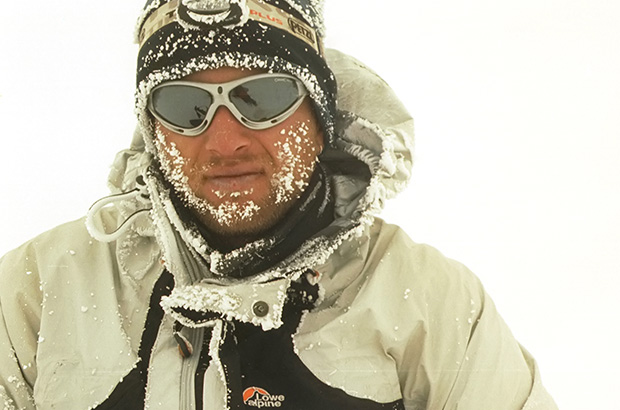
Humidity freezes and settles as frost on the clothes and faces of climbers during ascent of Mount Elbrus
But this is only in theory. In practice, the air temperature can vary within very wide limits while climbing Mount Elbrus - depending on the general weather conditions. In bad weather, in the conditions of a cyclone and low atmospheric pressure, the air temperature at all altitudes increases significantly.
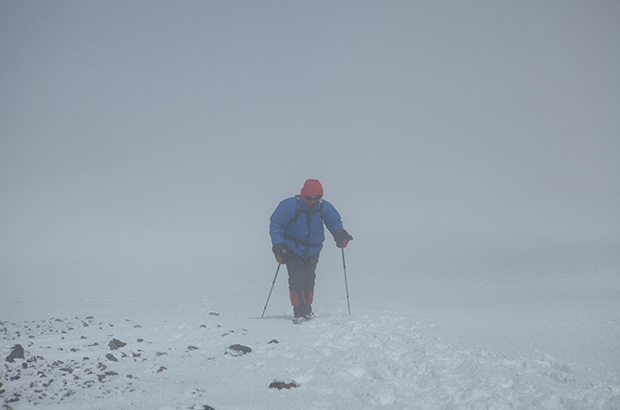
A sharp change in weather with decreased visibility is one of the main dangers of all the Mount Elbrus climbing routes
But this warming does not provide an advantage for climbing, since rising temperature is usually accompanied by strong winds and snowfalls. And vice versa - the most favorable conditions for ascent of Mount Elbrus are low air temperature and high atmospheric pressure (anticyclone). These conditions correspond to periods of stable clear weather, lack of precipitation and wind.
The graph below shows the data on the decrease in the air temperature as you gain altitude while climbing Mount Elbrus. For the calculation, the average temperature decrease for every 100 m was used - -0.6°C.
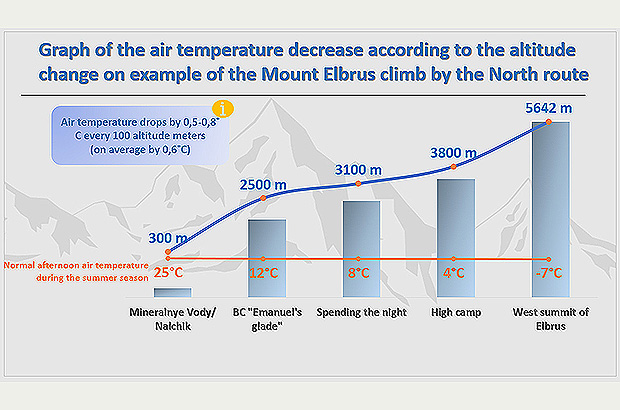
Graph of air temperature decrease relative to altitude
In addition, the actual air temperature in the mountains does not always correspond to how it feels at our usual altitudes. Unfortunately, accidents on the alpine climbing routes are not uncommon as, at a relatively safe and comfortable air temperature, climbers suffer or die from hypothermia.

Mount Elbrus is not a technically difficult mountain for climbing. But it is extremely demanding of the tactical skills of the leader and the discipline of the participants
This is due, first of all, to the fact that our subjective feeling of cold depends not only on the air temperature. But, to a greater extent, it depends on the accompanying objective and subjective factors - wind strength, humidity, physical fatigue and even the emotional state. Under unfavorable circumstances, you may find yourself in a situation when even a conventionally comfortable air temperature of +10 will be low enough to create a danger to life.
Russia Alpinist Federation statistics on mortality in the mountains and the number of novice climbers among those frozen in the mountains indicate that the cold factor and the likelihood of dying from hypothermia are underestimated especially by the beginners.
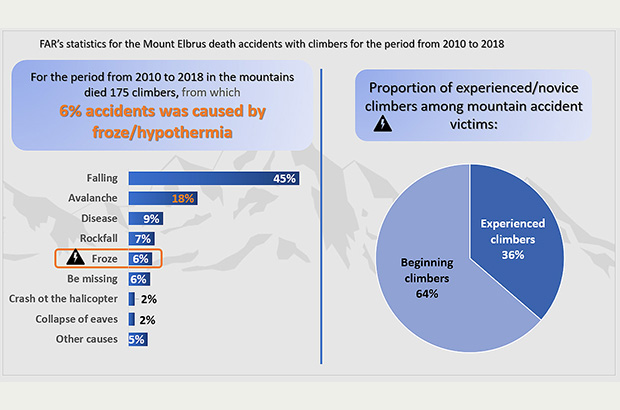
Graph of the relationship between the number and causes of mortality in the mountains
There was a case when, during rescue operations in Crimea, the author of this text observed signs of serious hypothermia in the victims of the climbing accident, while the air temperature did not drop below +12. High humidity, moderate wind and general physical exhaustion of the group of climbers who suffered an accident almost led to tragedy. By the time when our rescue team arrived, some members of the injured group were so frozen that they could no longer move independently.
While climbing Mount Elbrus along the West route
When drawing up a tactical plan for the Mount Elbrus ascent, one should take into account the factor of the dependence of the subjective sensation of air temperature on the combination of the actual temperature and the wind strength. This dependence gives a rough idea of how our sensation of cold can change.
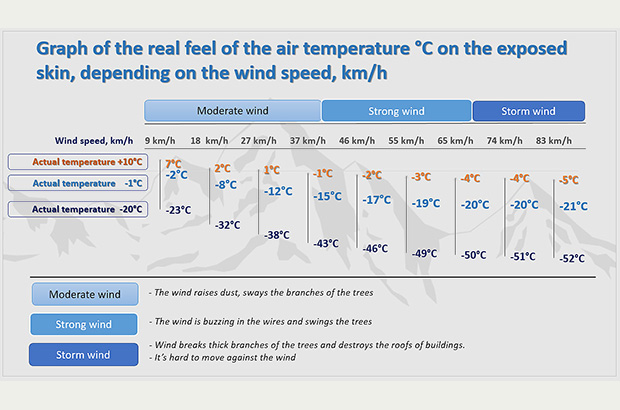
Illustration of the concept of Chill Factor - changes in the subjective sensation of temperature depending on the real temperature and wind strength
However, in reality there are additional factors that can greatly influence our feelings. This relationship is called the Chill Factor - it is a graph that allows you to get a general idea of how dangerous combinations of low temperatures and strong winds can be. For example, with an air temperature of -1˚C and a wind speed of 27 km/h (light wind), the Chill Factor is -12˚C, which would approximately correspond to our feeling of temperature on exposed skin. And at a temperature of -20˚С and a wind of 27 km/h, the subjective feeling of cold can correspond to a temperature of -38˚С which definitely requires special clothes and survival skills.
Strong wind, low air temperature, high altitude and general fatigue are a combination of factors that make climbing Mount Elbrus a difficult and very dangerous undertaking.
Practical recommendations for climbers, taking into account the information presented above, will be that when preparing for an ascent, one should take the issue of selecting gear and equipment as responsibly as possible. General tips on choosing clothes and shoes are outlined in the corresponding article in this section.
Here it is necessary to add that when climbing Mount Elbrus, you should not only be warmly dressed, but should be prepared for temperature changes within a very wide range, both below and above the zero.
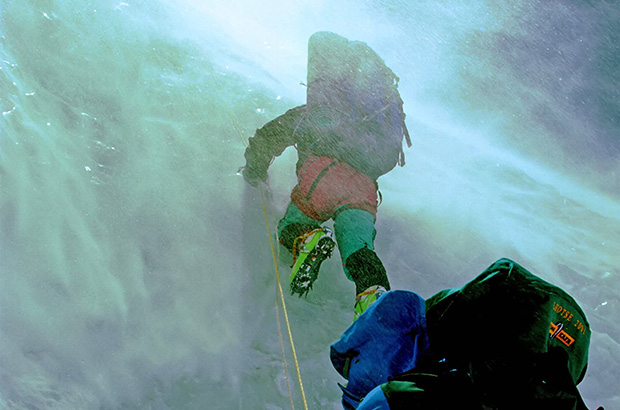
This is not Mount Elbrus route. But even the simplest ascent in the Caucasus Mountains can turn tragic if you take it without due seriousness and respect for the Mountain
Finally, just one practical example. Experienced climbers always take a light down jacket with them in reserve, even if the air temperature is comfortable enough for climbing in a light set of clothes. However, the alpine experience suggests that even with a slight increase of wind, if there is a slowdown in the pace of whole group, the need to take breaks and wait for those lagging behind, serious insulation of a set of clothes may be required.
The author of the texts and photographs Alex Trubachev
Your professional mountain guide for Mount Elbrus and other mountain climbing routes in Caucasus
MCS EDIT 2024
Other related questions:
- How much does it cost to climb Elbrus?
- How to get to the base of Elbrus from Moscow or Saint Petersburg?
- Which city is next to Elbrus? Transport logistics of the Mount Elbrus routes.
- How to prepare for the ascent of Elbrus?
- Is it possible to climb alone the highest mountain of the Caucasus and Europe - Elbrus?
- At what time of the year is it better to climb Elbrus?
- How long does climbing Elbrus last?
- What clothes and shoes do you need to climb Elbrus?
- What is the atmospheric pressure at the top of Elbrus?
- What sights are there on Elbrus on the way to the top?
Our Principles
AlexClimb Rule #1 - Safety First
From the very beginning of our activity, here nearly 16 years, the first Principle of work of School of mountaineering and rock-climbing of MCS AlexClimb is the Safety Priority. On the basis of this Principle all process of training is based, all programs and rounds are developed and carried out only within this main principle. We consider that at professional approach to development of programs, at personal discipline and correctly put motivation - occupations by mountaineering and rock-climbing are COMPLETELY safe. And from the return - all troubles and accidents in our sport come from nonprofessionalism, from ignorance or neglect by elementary standards of safety, from irrational motivation, from revaluation of own forces and opportunities. All these prerequisites we COMPLETELY EXCLUDE in our work - ours Rock-climbing, Ice climbing and Mountaineering are based on one Principle - the Safety Priority. In rock-climbing, mountaineering and ice climbing, the Priority of Safety of MCS AlexClimb-is your personal security and comfort irrespective of, than we are engaged - we train muscles and we work technology of the movement in the sports hall and on the rock climbing wall, we make the way through snowstorm to top or we relax on golden sand of the Caribbean beach after hot day of trainings on rocks. The Safety priority - the main credo of School of mountaineering and rock-climbing of MCS AlexClimb.
AlexClimb Rule #2 - Leave No Trace
Closely interacting with Nature, working with the active programs in mountains, woods, lakes and rivers, we perfectly understand the importance of carefull and respectfull bahavior towards the Nature, for its resources. From the very beginning of our outdoor-activity we adopted rules of Leave No Trace technique - the standard of behavior of the person accepted in all the civilized world in relation to environment and especially - to the wild nature. After all on the relation of people to the nature near which they exist, itself can draw dalekoidushchy conclusions on the relation of these people to... Where and as we didn't travel - we don't reserve any garbage, we try to reduce whenever possible our influence on environment to a minimum. We clear earlier zagryazyonny tourist parking of the left garbage, we take out and we take out to utilization places that to us other people left there. We consider that only thus, at personal individual consciousness of each citizen, each tourist, climber or autotraveller, we will be able to keep the nature surrounding us in its state, natural, suitable for life, - in it pledge of the healthy future for ourselves and our children.





